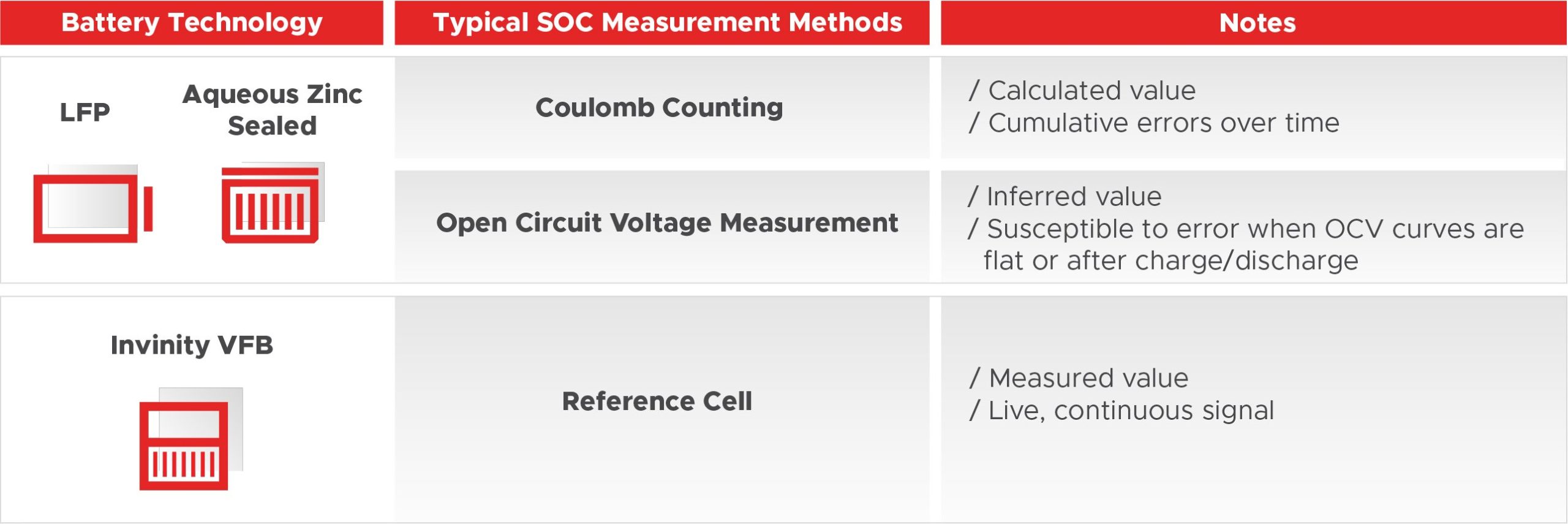Battery State of Charge (SOC) might sound technical, but it plays a crucial role in determining the success of any battery energy storage project. We unpack what it means to you, how it’s measured, and how to translate a vanadium flow battery’s accuracy into a sustained economic advantage.
The High Stakes of Getting Battery State of Charge Wrong
Today’s grid-connected storage systems are expected to deliver on multiple high-value applications such as energy arbitrage, frequency response, and participation in capacity and ancillary services markets. These applications all rely on the ability to accurately dispatch energy when needed. That requires knowing how much energy your battery can deliver, and for how long.
When SOC is inaccurately measured, the financial and operational consequences can be significant:
/ Lost revenue opportunities: If a battery operator underestimates SOC, they may hold back from bidding available energy into the market, resulting in lost income. This opportunity cost is especially painful during peak pricing events. In their excellent whitepaper on SOC inaccuracies in lithium iron phosphate (LFP) batteries, battery analytics firm Accure notes that “…misalignment reduces asset utilization, often causing immediate losses in revenue due to missed opportunities in periods of high demand or underperformance in energy trading.”
/ Penalties for underperformance: Overestimating SOC can be even more damaging. If the system is committed to dispatch energy it doesn’t have, operators face contractual penalties or must purchase energy on the spot market at elevated prices to meet obligations. Failure to deliver on contractual obligations can result in severe financial penalties; for example in the UK Capacity Market the penalty for non-delivery in a System Stress Event is up to 200% of the monthly capacity payment, while in IESO’s Operating Reserve market non-performance can lead to payment claw backs and the possibility of exclusion from further participation. Operators in ERCOT can similarly be exposed to base point deviation charges.
/ Reduced asset confidence and bankability: Inaccurate SOC readings undermine the reliability of performance reporting. This can erode investor confidence, complicate warranty claims, and affect the ability to finance and insure a project. Failure to operate some battery chemistries within a prescribed SOC can also lead to accelerated aging and degradation of the system, making accurate measurement critical for long-term operation. In the worst case this error can also increase the probability of a safety event such as thermal runaway in lithium-ion batteries.
Figure 1: Impacts of Inaccurate State of Charge on Key Energy Storage Project Stakeholders.

You can learn more about how different parties are impacted by various project technology costs in our article What Levelized Cost of Storage Means to Energy Project Stakeholders.
SOC Measurement: A Known Challenge for Lithium-ion and Zinc-Based Chemistries
Most conventional batteries such as LFP—and also newer aqueous zinc-based sealed batteries—rely on an inferred or calculated SOC using a combination of coulomb counting and voltage-based methods. Each approach has well-known limitations:
/ Coulomb counting tracks the current going into and out of the battery, calculating SOC from an initial known state. While theoretically sound, it accumulates error over time due to sensor drift and unmeasured parasitic loads, like balancing currents or power draw from the battery management system (BMS). A small undetected error can quickly snowball: TWAICE cites an example in which after only 20 cycles the SOC error can be as high as 20%, “meaning the storage can no longer be operated reliably.”
/ Voltage-based estimation uses the battery’s terminal voltage to infer SOC. However, this method struggles with chemistries like LFP that have flat open circuit voltage (OCV) curves. Over much of their operating range, voltage barely changes with SOC, particularly, says TWAICE, in the range of 40-80%. Furthermore, measurement can vary depending if the battery was recently charged or discharged, a phenomenon called the Hysteresis Effect. On a recent Modo Energy podcast, Shyam Srinivasan, CEO of Zitara Technologies, added that measuring voltage is even more complex during discharge and that OEM system estimates can often be 20-30% off.
Even advanced BMSs that combine both methods can only go so far. In live systems, BMSs often favour robustness and safety over precision. They must estimate battery state of charge under dynamic current load conditions and make assumptions about battery degradation over time. When combined with flat voltage curves and accumulating current sensor errors, these assumptions introduce significant uncertainty.
Aqueous zinc-based sealed batteries add further complexity as their chemistries are still evolving. Key challenges include dendrite formation, hydrogen evolution, and side reactions at the zinc anode—factors which can unpredictably affect performance and make SOC estimation even harder. Some vendors are working on electrolyte formulations and system designs to improve zinc battery stability, but accurate, real-time SOC measurement remains an open question.
Invinity Vanadium Flow Batteries Offer a Better Approach
Companies like TWAICE, Accure and Zitara offer add-on services for LFP owners that claim to provide more accurate SOC estimates, but the core technology in an Invinity vanadium flow battery (VFBs) allows for the use of a fundamentally more accurate method.
VFBs like Invinity’s store energy in liquid electrolytes held in tanks within the battery; these electrolytes are pumped through a cell stack where redox reactions occur as the battery charges and discharges. SOC in a VFB is directly tied to the ratio of different vanadium ions in the electrolyte. This chemistry opens the door to a far more accurate method of SOC measurement: using a reference cell.
Figure 2: Reference Cell in an Invinity Vanadium Flow Battery

How the Reference Cell Works
The reference cell in an Invinity VFB is a small, current-free cell that directly samples the same electrolyte used in the main system. Because no current flows through it, the voltage it generates represents the true electrochemical potential between the two electrolyte streams. This OCV correlates directly with the concentrations of vanadium ions and, by extension, the battery’s state of charge.
This setup provides a live, continuous, and accurate SOC signal without the drift or distortion introduced by current loads or voltage flattening. It uses well-understood electrochemical principles to convert OCV into SOC in real time, giving battery dispatchers certainty that the power or capacity is there when they need it.
Figure 3: Comparison of State of Charge Measurement Methods Across Battery Technologies

Commercial Advantages of Accurate SOC in VFBs
Using a reference cell for SOC measurement in VFBs delivers a number of practical benefits for storage operators, project developers, and investors:
/ Maximised revenue opportunities: With precise SOC data, operators can bid confidently into energy markets, knowing exactly how much energy they can dispatch. This is especially valuable during late-day price peaks or in frequency regulation services, where performance windows are tight and energy availability must be guaranteed.
/ Avoidance of financial penalties: Accurate SOC reduces the risk of under-delivery and the penalties that follow. In most storage markets, non-performance during ancillary service events can lead to significant financial losses. Trustworthy SOC measurement helps ensure delivery targets are met.
/ Improved operational decision-making: Real-time SOC enables more effective dispatch and charging strategies, minimizing costs and optimising realized round trip efficiency for a particular charge-discharge cycle.
/ Stronger project bankability: Demonstrable accuracy in key performance parameters like SOC increases investor and lender confidence. It supports better performance guarantees, enables more competitive insurance rates, and contributes to clearer, more credible reporting for long-term asset management.
Final Thought: Don’t Let Measurement Be a Margin-Killer
In energy storage, technical performance and financial outcomes are inseparable. Getting something as fundamental as SOC right—or wrong—can make or break a project’s economics.
Gaining accurate SOC measurements remains a key challenge for many BESS owners and operators utilising lithium or zinc based chemistries. Vanadium flow batteries offer a simple, robust solution: a reference cell that turns electrochemistry into actionable data. This enables better decisions, stronger performance, and higher confidence for operators, investors and everyone in between.
As energy storage becomes a cornerstone of grid infrastructure, SOC measurement is no longer just a technical concern – it’s a financial differentiator. For projects built on vanadium flow technology, it’s a powerful one.
Want to learn more? Contact our team today.